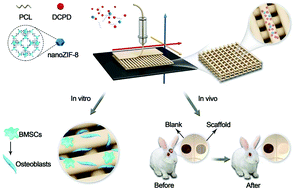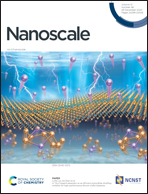3D printing of metal–organic framework incorporated porous scaffolds to promote osteogenic differentiation and bone regeneration†
Abstract
Bone substitute biomaterials, whose compositions and structures both play vital roles in bone defect healing, hold promising prospects in the clinical treatment of bone defects. Three-dimensional (3D) printed porous scaffolds incorporating osteoinductive components are considered as ideal bone grafts, because of the accurate control of structure parameters and the capacity to enhance bone tissue regeneration. Our previous studies demonstrated that nanoscale zeolitic imidazolate framework-8 (nanoZIF-8), a subclass of metal organic frameworks (MOFs), presented minimal cytotoxicity, inhibited bacterial activities, and promoted osteogenesis both in vitro and in vivo. However, the application of nanoZIF-8 in the 3D printed scaffold system remains unknown. In this study, nanoZIF-8 was incorporated into composite scaffolds composed of polycaprolactone (PCL) and dicalcium phosphate dihydrate (DCPD) via extrusion-based 3D printing technology. The results revealed that the composite scaffolds possessed increased mechanical strength and exhibited homogeneous structure with highly interconnected macropores. In vitro studies indicated that scaffolds showed biocompatibility to bone mesenchymal stem cells (BMSCs), significantly up-regulated the expression of osteogenesis-related genes and proteins, and facilitated the extracellular matrix mineralization. In vivo results showed that 3D printed porous scaffolds promoted new bone formation and enhanced micro-architecture at the critical defect sites (Φ10 mm) in rabbits, compared with the blank control group. Moreover, composite scaffolds significantly improved calvarial defect healing in comparison with scaffolds without nanoZIF-8 incorporation. In summary, nanoZIF-8 modified 3D printed porous composite scaffolds demonstrated great potential in the treatment of critical-sized bone defects, proving the effectiveness of MOF incorporation in 3D printed composite scaffolds to promote osteogenesis in the field of bone tissue engineering.



 Please wait while we load your content...
Please wait while we load your content...